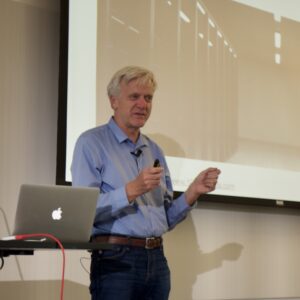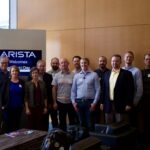|
|
 Andy Bechtolsheim presents for Arista Networks at Networking Field Day 16 |
This Presentation date is September 13, 2017 at 15:30 - 17:30.
Presenters: Andy Bechtolsheim, Anshul Sadana, Ken Duda, Russell Kelly, Ryan Madsen
Arista Introduction and Overview with Anshul Sadana
Watch on YouTube
Watch on Vimeo
Anshul Sadana, SVP and Chief Customer Officer at Arista, updates the delegates on the state of Arista. The company has evolved from Leaf-Spine designs for data center networking and now has moved into spine interconnects between data centers. He also discusses the companies move into supporting IP storage, spine routing, cloud peering, and security monitoring.
Personnel: Anshul Sadana
Andy Bechtolsheim on the 400 Gigabit Landscape
Watch on YouTube
Watch on Vimeo
Andy Bechtolsheim, Founder, Chief Development Officer and Chairman at Arista, reviews how Arista is preparing for the 400 Gigabit future. While 100G Ethernet is gaining ascendency now, by 2021 he sees the 400G port numbers reaching parity with 100G Ethernet. The optics for this will be powered by 100G per lane, as defined by the 100G Lambda MSA consortium. He further reviews how this standard will allow for more seamless transition to 400G than the standards proposed by the IEEE.
Bechtolsheim highlights the rapid growth of 100 Gigabit Ethernet, which is expected to continue its ascendancy until 2021 when 400 Gigabit ports will start to reach parity. He explains that the transition to 400G will be facilitated by the 100G per lane standard defined by the 100G Lambda MSA consortium, which Arista is a part of. This standard is seen as more efficient and forward-compatible compared to the IEEE’s proposals, which have been slower to finalize and less practical in terms of implementation.
Bechtolsheim also discusses the technical intricacies and market dynamics of Ethernet and optical lane speeds, emphasizing the importance of lower power consumption and cost-effectiveness in driving adoption. He outlines the progression from 25G lanes to 50G and eventually to 100G lanes, noting that the latter will become the dominant standard due to its efficiency. The presentation also touches on the challenges and solutions related to form factors, such as the OSFP and QSFP-DD, and the importance of forward and backward compatibility in optical modules. Bechtolsheim concludes by stressing the economic drivers behind the rapid adoption of new standards and the potential future limitations of electrical lane speeds, hinting at a possible transition to photonics as a long-term solution.
Personnel: Andy Bechtolsheim
Arista EOS Programmability with Ken Duda
Watch on YouTube
Watch on Vimeo
Ken Duda, Founder, CTO and SVP Software and Engineering at Arista, has worked in networking for decades, but is a programmer at heart. He reviews the how the EOS architecture is different from other switches, starting from it’s simplified single binary image. This allows for standardization across an entire environment. This is enhanced by their state oriented approach, which allows for off-box programmability. All of this is backed by a commitment to “true” Linux with an off the shelf Linux distribution.
Personnel: Ken Duda
Arista Networks Automation and Telemetry with Ryan Madsen
Watch on YouTube
Watch on Vimeo
Ryan Madsen, Manager Software Engineering, begins this session why explaining why Arista entered into the crowded monitoring market. This was a response based on the customer need to obtain comprehensive state from boxes in real time. This leads into an overview of their answer, CloudVision Telemetry. He then reviews how the system operates in a live demo.
Personnel: Ryan Madsen
Arista Networks Routing Architecture Transformations with Russell Kelly
Watch on YouTube
Watch on Vimeo
Russell Kelly, Technical Marketing Engineer, gives an overview of how Arista is positioned to attack the routing space, with a combination of silicon and programability. This is informed by a transformation in routing architecture based around cloud principles that have driven transformation in most other enterprise infrastructure already. He then gives an overview of the scalability of their approach with FlexRoute.
Personnel: Russell Kelly








